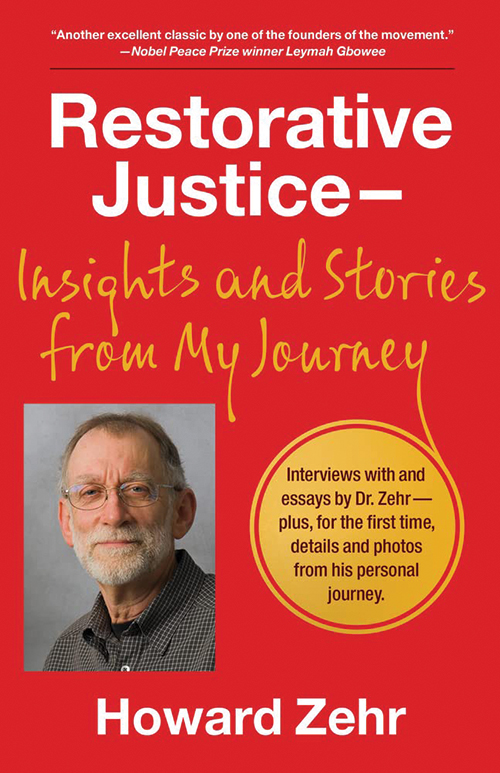
Restorative Justice: Insights and Stories from My Journey
Reviewed by Pamela Haines
March 1, 2024
By Howard Zehr. Walnut Street Books, 2023. 224 pages. $16.99/paperback; $8.99/eBook.
This collection of essays, reflections, and photos by Howard Zehr goes beyond his well-known Little Book of Restorative Justice, published 22 years ago. Offering a wider lens on his background, interests, and identity as an artist, I found it a gem.
Since I hadn’t read Little Book, I appreciated the recap. Restorative justice replaces the usual questions—what laws were broken, who did it, and what do they deserve—with new ones: who’s been hurt, what are their needs, and who has obligations. Offender, victim, and community are part of a common search for a genuine solution: one that meets the requirements of justice and is based in respect, responsibility, and relationship. While our legal system focuses on minimal permissible behavior and our culture emphasizes rights over responsibilities, restorative justice offers a more comprehensive moral vision of how we should live together.
While personal and informal in tone, this retrospective addresses big issues. Tragedy and trauma are commonly present for both victim and offender, with wrongdoing often a symptom of some harm or need in a person’s life. Since trauma that is not transformed is transferred, Zehr speaks of finding a road to transcending trauma through reconnection. Shame is at the heart of much violence, he says, yet the traditional process of criminal justice often increases shame for all parties. Rather than a transfer of stories of shame from one to another and back again, a transformation is needed into stories of dignity, courage, and honor.
This involves giving voice to our pain and telling our truths. The circle process in restorative justice practice slows us down, providing space for what Elise Boulding calls “prophetic listening” to ourselves and others. Making that space for empathy, reconnection, truth telling, and healing can be seen as a form of radical participatory democracy.
Noting how our current system increases “othering,” and how an alternative path can lead toward more wholeness and belonging, Zehr suggests that we be humble about what we think we know, acknowledging that our “truths” are affected by who we are and what we have experienced, and that we instead reach for a sometimes uncomfortable engagement with others. This focus on interconnectedness and relational wellness, at the core of restorative justice, can also help catalyze a larger effort to build a culture of peace and a peacebuilding approach to justice.
Zehr is clear that he is not the “father” of restorative justice; its principles and practices have been articulated by many others from diverse traditions and perspectives. Rather, he works to articulate the best of such traditions, in a way that connects with both biblical justice and contemporary Western thought. His work at Eastern Mennonite University’s Center for Justice and Peacebuilding has created a space where wisdom can come forth, and this has sparked connections and projects throughout the world. An unexpected delight in the book was coming across pages and pages of testimonials from people all over the world, clearly jumping at the opportunity to say what he and his work have meant to them.
I was particularly moved by the deeply human and respectful photo portraits of people who are in prison for life. By communicating people’s realities to others who do not know them, he sees how such art can offer a healing edge, and how moving from abstractions and stereotypes to real people can reduce social distance. He notes that creating such respectful portraits allowed his subjects to see themselves in a new light as well. As both an artist and a justice practitioner, he speaks of the power of beginning not with Western skepticism but with wonder. On this point, he quotes nature photographer Steven Meyers: “one’s knowledge must never overcome one’s awe.”
I found that reading this book was like participating in a gathered meeting. Zehr, a Mennonite in our peace church tradition, has risen to speak, tuned into the deep bass drumbeat of love that is at the heart of the universe, and stands in humility and awe. As he draws on everything he has taken deep into his heart and all the experiences of a well-lived life, his words have the ring of truth. This book calls out for a place in the library of every meeting and Friends school, and in the heart of every Friend.
Pamela Haines is a member of Central Philadelphia (Pa.) Meeting. Author of Money and Soul, her newest titles are Tending Sacred Ground: Respectful Parenting; The Promise of Right Relationship; and a third volume of poetry, Tending the Web: Poems of Connection. She blogs at pamelahaines.substack.com.



Comments on Friendsjournal.org may be used in the Forum of the print magazine and may be edited for length and clarity.